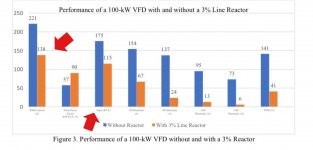Judis
Member
- Location
- Conover, Ohio
- Occupation
- Technical mechanic
I have 480v, 200amp fusible disconnect going to a main cabinet of a Ward/ Flex machine. At the bottom of these fuses there are four small motors and an old dc drive that moves a 500vdc, 300amp SHUNT motor. When this machine is running at a good rate it has 22amps being read at the input fuses and around 50amps at the motor.
I decided to add a 480vac, 50hp blower motor at the bottom of these fuses as well (46amps while running) You can see the blower motor from the main cabinet, its about 50' away. Just before the dc drive there is a "Line Reactor" that helps wilt isolating spikes and I also wired a 480v to 480v, wye isolating transformer after a 60amp fusible disconnect, to an AB motor contractor for the blower motor circuit.
I'm hoping that the amps and the spikes would be maintained enough having the line reactor and the isolation transformer in between the dc drive that runs the main motor of the machine, wanting to keep the drive healthy? I could have run a separate line to the blower from across the plant but I was hoping to save time and money!
Judis
I decided to add a 480vac, 50hp blower motor at the bottom of these fuses as well (46amps while running) You can see the blower motor from the main cabinet, its about 50' away. Just before the dc drive there is a "Line Reactor" that helps wilt isolating spikes and I also wired a 480v to 480v, wye isolating transformer after a 60amp fusible disconnect, to an AB motor contractor for the blower motor circuit.
I'm hoping that the amps and the spikes would be maintained enough having the line reactor and the isolation transformer in between the dc drive that runs the main motor of the machine, wanting to keep the drive healthy? I could have run a separate line to the blower from across the plant but I was hoping to save time and money!
Judis


